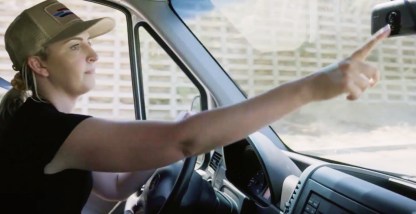In the transportation industry, commercial fleets invest in dashcams to proactively prevent accidents. Yet as human beings, we rarely take proactive steps to prevent accidents in our daily conversations. After all, having a conversation seems easy enough. One person talks, the other listens. What could go wrong?
The reality, of course, is more complex. The space where words meet the air can be a vast realm of misunderstanding. According to a survey about miscommunication in the workplace, more than 80% of workers said miscommunication occurred in their organizations frequently or occasionally, while only half admitted to participating in miscommunication themselves. “These results reveal that accountability is critical and often overlooked in an organization,” the survey concluded.
We turned to communications consultant Shelley Row P.E., CSP, founder and CEO of Blue Fjord Leaders, for insight into why miscommunication happens and what fleets can do about it. By taking a proactive approach to coaching conversations, drivers and coaches can prevent accidents in their discussions just as they do on the road.
Fending off ‘saber-toothed tigers’ at work
As a consultant helping organizations improve communication, Row has heard it all — from deafening silence to cursing in the halls. She’s a registered engineer, a certified speaking professional, and a self-proclaimed “recovering overthinker.” But her training at the NeuroLeadership Institute gives her the most nuanced perspective on human interaction.
“Poor communication happens when there is a disconnect between what is said and what is heard,” Row says. “Anytime the brain is in a reactive or triggered state, the thinking part of the brain goes offline. It makes for poor decision making and ineffective communication.”
When an incident in our orbit fails to align with our expectations, we go into a fight-or-flight response, as if facing the same threats cavemen faced in prehistoric times. In the Stone Age, feeling triggered helped cavemen survive in the face of predators.
“The brain is designed to keep us safe,” Row explains. “It’s constantly on the lookout for threats. Eons ago, the threat would have been a saber-toothed tiger. Today, we’re not facing saber-toothed tigers, but the brain thinks we are.”
“Saber-toothed tigers” spring to life in the workplace whenever people feel threatened. If a driving coach has a strong safety mindset, for example, and they have a driver who’s using a cell phone at the wheel, it could trigger the coach to react.
“That coach’s brain is going to pick up on cell phone use and think, ‘That behavior is not okay,’” Row says. “The coach’s brain recognizes that using a cell phone doesn’t align with his or her expectations. Any unsafe driving behavior, such as swerving, speeding, or taking eyes off the road, is going to register to the coach as a saber-toothed tiger.”
Fortunately, there are ways to dial down a fight-or-flight response in real time. “It’s all about self-awareness,” Row says. “The more we understand about ourselves, the better we can manage our emotions proactively.”
Row’s four-step approach to better communication will have drivers and coaches managing their emotions soon enough. All it takes is a little awareness and a whole lot of willpower.
Want more tips? Read: 3 ways to coach drivers to safer behavior.
1. Recognize when you’re triggered
In the midst of a difficult conversation, anyone can be set off. The good news is, there’s always a way to return to center. “When the nervous system goes into a fight-or-flight reaction, it shows up in our body as tension, such as tightness in the jaw or tightness in the chest,” Row explains. “Recognizing these physical indicators gives us a clue that we’re in a reactive mode, letting us know that we need to manage our emotions.”
2. Begin to defuse the situation
Once you recognize that you’re triggered, stop to assess your feelings. “Allowing for a short break gives the nervous system a chance to settle down,” Row says. “If you don’t have the luxury of being able to take a break, then breathe deeply, relax your posture, and focus on feeling your body in the chair. These techniques help rebalance the nervous system. They’re the same techniques our parents taught us in kindergarten when they told us to count to 10, and they’re still effective all these years later.”
3. Look for common ground
Finding common ground goes back to what Stephen R. Covey wrote in “The 7 Habits of Highly Effective People.” “Seek first to understand, then to be understood,” Row says. Understanding can be achieved through reflective listening, a technique in which the listener works to understand the speaker’s idea then repeats it back to them to confirm it was understood correctly.
“A coach or a driver could say, ‘What I hear you saying is this. Did I get that right?’’’ Row explains. “Sometimes people get it right, other times they don’t. Don’t be afraid to try again. Reflective listening is a simple tool, but it makes a big difference in the accuracy of the conversation. It can be even more powerful in making the other person feel like they’ve been heard.”
Row has seen firsthand the power of reflective listening. As it validates the other person, it takes the relationship to a more positive place. “By repeating the driver’s words back to them, they will sense the coach is interested in their point of view,” she says. “It calms down the brain and will make the driver more interested in understanding the coach’s perspective. It really improves the relationship.”
4. Close out the conversation with a clear directive
Before parting ways, the coach should get insight into the driver’s understanding of what the next steps are. Row encourages coaches to end by saying, “‘Let’s look back on what we’ve just agreed to.’ Ask the driver to repeat the safer habits that have been discussed. Ask them to recount the steps they plan to take next. Taking this approach is integral to closing out the coaching session with clarity and accountability.”
Row has learned the hard way how useful it can be to close out the conversation with reflective listening. She has found that what two people believe was agreed to often differs. “Sometimes I think, ‘Were we in the same meeting?’” Row laughs. “As a coach, you don’t know what is in your driver’s head. By asking them to recount the directive, you can find out.”
When a coach asks a driver to repeat the next steps, it gives the coach a chance to correct any misunderstandings. But be careful not to be condescending, Row cautions. When a driver or anyone else is asked to repeat something back, it can come as a surprise.
“It’s important to speak in an understanding tone,” she says. “You could say, ‘Just to make sure we’re on the same page, why don’t you repeat back to me what you think the next steps are.’ Communication is meant to effectively exchange information while enhancing the relationship. At every step of the conversation, work toward that goal.”
Get more great tips about improving the driver-manager relationship in our blog post “It’s not pay, it’s a phone call.”
Are you interested in working with Shelley to improve communication at your organization? Connect with her here.
Driver safety resources
Explore resources to maximize fleet safety and improve your driver coaching program.









